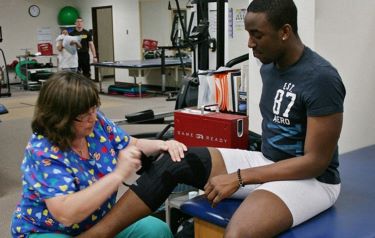
Physical therapists provide care to people of all ages who have functional problems resulting from back and neck injuries, arthritis, neurological disorders, and injuries related to work or sports. Physical therapists are educated to use a variety of different techniques to care for their patients including training in functional movement of joints, muscles, and other soft tissue to improve health and decrease pain. The work of physical therapists varies by type of patient. For example, a patient working to recover mobility lost after a stroke needs different care from a patient who is recovering from a sports injury. Some physical therapists specialize in one type of care, such as orthopedics or geriatrics.
Physical therapist assistants help physical therapists provide care to patients. Under the direction and supervision of physical therapists, they treat patients through exercise, massage, gait and balance training, and other therapeutic interventions. Physical therapist assistants record patients progress and report the results of each treatment to the physical therapist. Physical therapist assistants and physical therapist aides work under the direction and supervision of physical therapists. They help patients who are recovering from injuries and illnesses regain movement and manage pain.
There are more than 200 programs for physical therapists accredited by the Commission on Accreditation in Physical Therapy Education (CAPTE). All programs offer a Doctor of Physical Therapy (DPT) degree. DPT programs typically last 3 years. Many programs require a bachelor's degree for admission as well as specific educational prerequisites, such as classes in anatomy, human physiology, biology, and physics. Most DPT programs require applicants to apply through the Physical Therapist Centralized Application Service (PTCAS).
Physical therapist programs often include courses in biomechanics, anatomy, physiology, neuroscience, and pharmacology. Physical therapist students also complete at least 30 weeks of clinical work, during which they gain supervised experience in areas such as acute care and orthopedic care. Physical therapists may complete a clinical residency program after graduation. Physical therapists who have completed a residency program may choose to specialize further by completing a fellowship in an advanced clinical area from the American Board of Physical Therapy Residency and Fellowship Education.
Physical therapist assistants entering the profession need an associates degree from an accredited program. All states require physical therapist assistants to have an associates degree from an accredited physical therapist assistant program, and acquire a license to work. Programs typically last 2 years. Classroom study includes courses in algebra, English, anatomy, physiology, and psychology. Assistants also gain hands-on experience during supervised clinical work. They may earn certifications in cardiopulmonary resuscitation (CPR), basic life support (BLS), and other first-aid skills.
Pain on the inside of the knee, right where the knee bends, is often thought to be a meniscus tear, when in fact it might be something called a tibial shift.
How to correct your forward head posture to alleviate neck and shoulder tension and pain. Feel better fast with these exercises you can do right at home to improve your neck and upper back posture.
This nursing skills video will show you how to properly elicit a response in the patellar tendon by finding the tendon below the knee. This is best done by extending the knee which will cause the patellar tendon to become more pronounced.
Specific schools have their own requirements, but generally speaking, take classes in the pysical sciences, as well as anatomy (with lab), physiology, and psychology.
All states require physical therapists to be licensed. Licensing requirements vary by state but all include passing the National Physical Therapy Examination administered by the Federation of State Boards of Physical Therapy. Several states also require a law exam and a criminal background check. After gaining work experience, some physical therapists choose to become a board-certified specialist. The American Board of Physical Therapy Specialties offers certification in nine clinical specialty areas of physical therapy, including orthopedics, sports, and geriatrics. Board specialist certification requires passing an exam and at least 2,000 hours of clinical work in the specialty area within the last ten years or completion of an American Physical Therapy Association (APTA)-accredited residency program in the specialty area.
What about physical therapist assistants?Licensure typically requires graduation from an accredited physical therapist assistant program and passing the National Physical Therapy Exam for physical therapist assistants. The exam is administered by the Federation of State Boards of Physical Therapy. Some states require that applicants pass an exam on the states laws regulating the practice of PTAs, and complete a criminal background check.
Ask yourself if you can see yourself being a physical therapist assistant, having daily contact with patients who may be disabled, or recovering from surgery. Other patients may feel irritable, which can be challenging. While classes and internships will prepare you well, certain innate qualities that you bring to bear will help you succeed.
Attending college offers benefits beyond academic learning. Students are exposed to diverse perspectives that challenge their thinking. This fosters problem-solving and communication. College is also about social skills. Whether through student organizations or sports teams, students develop leadership skills and build lasting friendships.
This website is not affiliated with any educational institution, and all trademarks are the exclusive property of the respective owners. All copyrighted works on this website are offered for educational purposes only, governed by the four-factor rule, section 107 of the Copyright Act. CampusInspector.com is the work of a group of students in Bangkok, using data from the US Department of Education, Postsecondary Education Data System (IPEDS). If any information is incorrect, please contact us with updates.